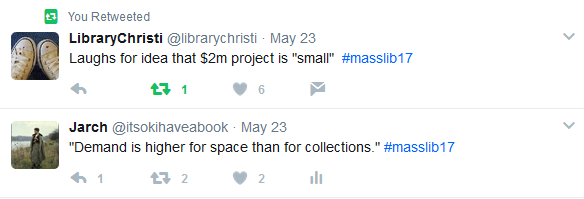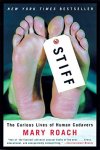This is part II of my recap of the Massachusetts Library Association (MLA) Conference on May 23. Read part I here.
Mind in the Making: Creating Play & Learn spaces at your library
Katrina Ireland-Bilodeau (Northborough Free Library), Mia Cabana (Jones Library, Amherst), Steve Fowler (Bellingham Public Library)
Mind in the Making (MITM) is an MBLC/LSTA grant that all three of the presenters’ libraries applied for and won; they presented about how they used the grants at their libraries. Mind in the Making: The Seven Essential Life Skills Every Child Needs is also a book by Ellen Galinsky of the Families & Work Institute.
MITM is an “effort to share the science of children’s learning with the general public, families and professionals who work with them” – including, of course, librarians. Why libraries? We already have engagement (parents bring their kids) and community partnerships (people trust libraries).
Katrina, Mia, and Steve all shared wonderful ideas they had implemented in their libraries, from making changes to the physical space, to buying new furniture and toys, to incorporating educational tips into storytimes and other children’s programs. Here are some of the ideas they put into action:
- Repurpose under-utilized space
- Refresh rooms with new carpets and paint
- Define different play zones for different ages
- Borrow ideas from children’s museums (the Fall River Children’s Museum was name-checked; I recently saw a “mouthed toys bin” at the Boston Children’s Museum)
- Get new furniture and toys to fuel imaginative play
- A “dramatic play center” can be a puppet theater, grocery store, bank, farmer’s market, doctor’s office, and more – rotate themes regularly
- Train tables are always popular!
- Lakeshore and Playscapes were mentioned, but if you don’t have a budget, look for donations or see if a local vocational school can build something that you can buy for the cost of the materials
- MagnaTiles are “one of the most imagination-fueling toys” and good for all ages
- Blocks and animal figures are a must-have. Get alphabet blocks in other languages – reflect your community
- Incorporate play into storytimes
- Label toy bins with pictures of the contents (for kids) and educational tips (for caregivers)
- Make connections with other community organizations
- Is a plain or ugly surface showing, like the back side of a shelf or desk? Cover it with felt and make a felt board. (Or make a chalk board or a magnetic board…)
- Move underused collections around; one library put their parenting collection on a mobile cart so they can bring it in to children’s programs for caregivers to browse
- Vroom cards were also mentioned (“Vroom turns shared moments into brain building moments”)




As the libraries made the changes mentioned above, library staff saw changes in their children’s spaces: parents engaged with their children more, there was less arguing over toys, spaces were less messy because kids were better about cleaning up (“a place for everything and everything in its place” only works if everything has a place).
It’s not enough to get a bunch of new toys – there has to be intentionality. Librarians can model how to make connections between play and learning (for young children, play is learning) so caregivers can do the same.
YA Smackdown
During the “YA Smackdown,” about a dozen of us sat around on chairs and on the floor in one of the unused rooms at lunchtime. Prompts were pulled out of a box and anyone who had something to contribute spoke up. It was “a fun, low-key environment,” as promised. A comprehensive set of notes [PDF] are available from the MLA YSS wiki, so here is just a sample of our discussion from my notes:
Q: What’s the most successful Banned Books Week display you’ve done or seen?
A: (1) Covering book covers with brown paper and writing the reasons the books were banned on them (language, sex, violence, talking animals, etc.); (2) Making new book covers that illustrate the opposite of the book’s title (e.g. David Levithan’s Two Boys Kissing becomes Two Boys Not Touching At All).

Q: How do you encourage kindness?
A: Model it! Say hello to teens when they enter, goodbye and “hope to see you again soon” when they leave (even/especially if they’re being kicked out). Participate in the Kindness Rocks project, which leaves kind messages painted on stones for people to find. Don’t allow insults (“Did you mean that as an insult? You can’t say it”).
Q: How do you connect teens with community resources?
This can be tricky, but one good idea used by Mattapoiset is to create a binder full of resources in the teen area. They can look through it without checking anything out, and take copies of anything they might need.
Q: What’s your favorite part of the day?
Coffee! No, seriously, readers’ advisory – “let’s go browse” the shelves to find some books. When teens come up to ask questions. Ordering books, receiving and unpacking new books.
Q: Recommended books with good racial/ethnic diversity?
A: The Hate U Give by Angie Thomas, The Upside of Unrequited and Simon Vs. The Homo Sapiens Agenda by Becky Albertalli, the Ms. Marvel graphic novels, The Inexplicable Logic of My Life by Benjamin Alire Saenz, The Lotterys Plus One by Emma Donoghue (for tweens and up), The Sun Is Also A Star by Nicola Yoon, Midnight Riot by Ben Aaronovitch (first book in the Rivers of London series – for older teens and adults).
Step Into Your Office: The Library as a Coworking Space
Susannah Borysthen-Tkacz (Cambridge Public Library), Gregor Smart (Boston Public Library – Kirstein Business Library and Innovation Center), Patrick Yott (Northeastern University Libraries)
Susannah moderated this session, guided by the overarching question “Is coworking a novelty or a profound shift in how we do things?” Statistics indicate that more and more of the workforce is made up of entrepreneurs, “solopreneurs,” and nontraditional workers. How can the library best serve these people?
One type of place we can take inspiration from is paid co-working spaces, like Workbar, which offer physical space (sometimes with 24/7 access), open work space, desks, locking file cabinets and storage space, meeting rooms, phone rooms, mail, a dining area, event space, and access to the other members to create an instant network and encourage “accelerated serendipity.” Co-working spaces aren’t free, though, so many people may choose to work at the library instead.
The library may not be able to offer all of the things that co-working spaces can, but we have one thing co-working spaces don’t: librarians. Most co-working spaces are unstaffed, and don’t offer research help or access to databases or other resources.

Gregor and Patrick talked about the changes that have been made at Kirstein and Northeastern’s Snell Library, respectively. Gregor said that people want spaces for small meetings, webinars, learning languages, etc; it’s constantly a challenge to meet demand for collaborative workspaces. Both libraries use moveable screens (or, better yet, moveable whiteboards) so people can reconfigure the space as needed. Built-in alcoves are first-come, first-serve, while meeting rooms and work stations (Macs loaded with specialized software like Garage Band, PhotoShop, and Illustrator) can be reserved. Large event space can be rented.

Most libraries won’t have a budget for a major redesign like Kirstein and Snell, but there are ways we can serve those who are seeking space to work solo or collaboratively. In fact, “Demand is higher for space than collections” might be the theme of most of the sessions I attended at MLA this year, from “Transforming Teen Spaces” to “Mind in the Making” to “Step Into Your Office.”

If there’s any space in your library that is under-utilized (and have you weeded your print reference collection yet??), see if you can carve out spaces with movable screens. If you are buying furniture, make sure it moves too. Consider: is your food & drink policy friendly to people who use the library for long stretches of time? What is your policy on cell phones? (On Wednesday, there was a session about Private Talking Spaces from the Harvard Library Innovation Lab. I am curious to know more!)
That was the last session of the day for me. I enjoyed reading tweets from the other sessions throughout the day and afterward; the conference hashtag was #masslib17 if you want to catch up via Twitter. Did you go to the conference? What were your most exciting/useful/important takeaways?







 Bill Bryson is well-known and well-liked; you’ve probably heard of (or already read)
Bill Bryson is well-known and well-liked; you’ve probably heard of (or already read)  Boston surgeon Atul Gawande is also a wonderful author, who writes with medical expertise and deep empathy, and is driven by a constant desire to improve. His most recent book is
Boston surgeon Atul Gawande is also a wonderful author, who writes with medical expertise and deep empathy, and is driven by a constant desire to improve. His most recent book is  I discovered Steven Johnson through his book
I discovered Steven Johnson through his book  Erik Larson is another perennially popular nonfiction author, and with good reason: his well-researched books often use multiple narratives to tell the same story, enhancing the aspect of suspense through different perspectives. The pacing, particularly in his latest,
Erik Larson is another perennially popular nonfiction author, and with good reason: his well-researched books often use multiple narratives to tell the same story, enhancing the aspect of suspense through different perspectives. The pacing, particularly in his latest,  Mary Roach‘s clever one-word titles (with the exception of
Mary Roach‘s clever one-word titles (with the exception of  If you only ever read one 900+ page book in your life, there is a very good case for
If you only ever read one 900+ page book in your life, there is a very good case for  Even wonder what would happen to Earth if all the humans just…disappeared? Alan Weisman takes that thought experiment and expands it into a book in
Even wonder what would happen to Earth if all the humans just…disappeared? Alan Weisman takes that thought experiment and expands it into a book in  Joan Didion: There are too many books to list here, but try her memoirs,
Joan Didion: There are too many books to list here, but try her memoirs,  Stephen King: King is best known for his novels, of course, but his book
Stephen King: King is best known for his novels, of course, but his book  Gretchen Rubin:
Gretchen Rubin: 
